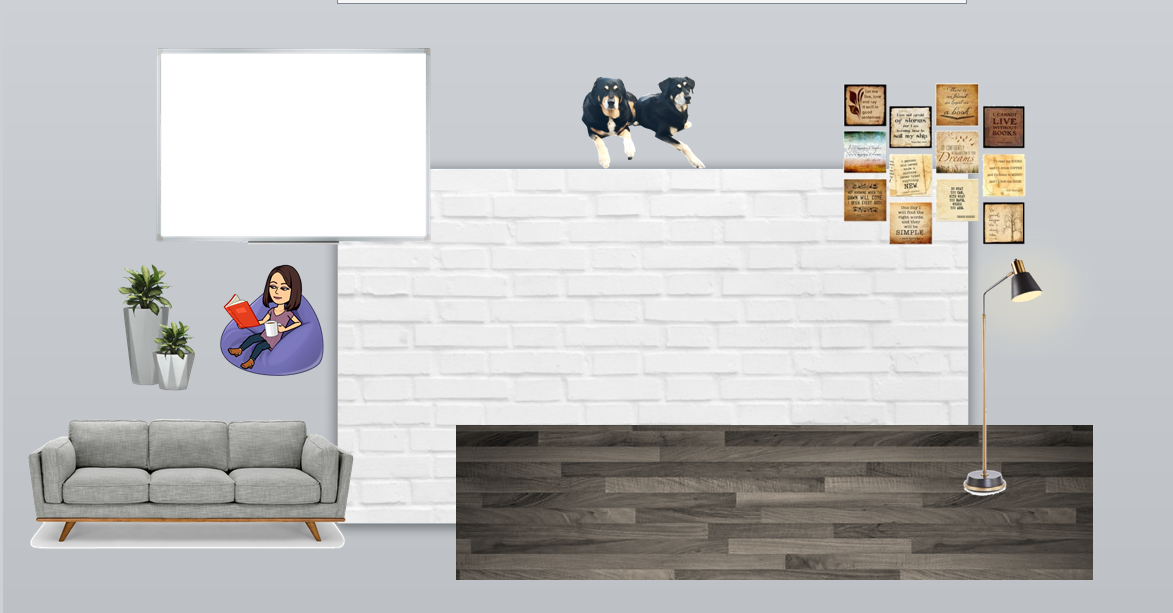How to Create a Virtual Bitmoji Classroom in Google Slides or PowerPoint
I recently posted this photo of my Google Meet slide on Instagram and had some folks request a more detailed tutorial. Since creating tutorials is one of my favorite ways to procrastinate on other more pressing tasks, I will gladly oblige. Here we go.
What you’ll need 📁
A blank Google Slides or PowerPoint file
The Remove.bg website
Step 1: Open a blank Google Slide or PowerPoint 🖱️
If you want to create a Google Meet or Agenda slide like mine (or something similar), you can keep the default page dimensions and move onto Step 2.
If you want to create a Google Classroom header, change the page dimensions to 1,000 x 250 pixels by going to File —> Page Setup in Google Slides or Design —> Page Setup in PowerPoint. Just a warning though: When you upload your banner on Google Classroom, you’ll get this frustrating dark overlay on your image. It’s an accessibility thing and can’t be changed, so just keep that in mind and try to keep everything as bright as possible.
To create a custom Google homepage, you’ll want the dimensions somewhere in the neighborhood of 15 in x 8 in.
Step 2: Collect your images 🖼️
Next step is to collect the images for your scene.
For mine, I used posters from ECHO-LIT (my favorite poster shop) and a variety of Google Images. All Google Images were found using the “labeled for reuse” filter (more on that in a minute). I also want to note that I reached out to the creator of ECHO-LIT for permission to use her posters in my scene. Please do the same if you decide to include something similar.
For the background, I searched Google for “white brick wall” and “wood floor” — then I just arranged them on the page in a way that looked semi-normal. You could also search for something like “wall floor” and grab an image that already combines the two.
To get your Bitmoji in Google Slides, download the Bitmoji Chrome extension. Then, click the Bitmoji icon on your browser bar, select the Bitmoji you want, and drag and drop it onto the slide. To get your Bitmoji in PowerPoint, click on the Chrome extension icon, right-click on the Bitmoji you want, and save it as an image — then you can insert that image into your PowerPoint slide.
Bitmoji Search Tip: If you’re having trouble finding a standing Bitmoji without additional text or art, type “pose” into the Bitmoji search bar!
Google Image Search Tips: 🔎
To help with your image search, there are a few filter tools you need to know about. Filtering your search will allow you to find the images you need a lot quicker (and it’s also a helpful trick to teach students, too!).
Go to Google images and click on Tools. This will bring up a variety of filter dropdowns.
Here are the filters I find most helpful:
To find images that are labeled for reuse, click Usage Rights —> Labeled for reuse. Yes, it’s tempting to type a few search terms into Google and grab whatever images we want without thinking twice, but that could very likely turn into a big ol’ copyright violation. Plus, don’t we teach our students that’s not okay? Yay for modeling digital citizenship!
If you want to find something in a specific color, click Color and select the color you want.
To find images with transparent backgrounds, click Color —> Transparent background. If you can’t find an image you like that fits this criteria, that’s okay — that’s what the remove.bg website is for (but this filter allows us to skip that step).
To remove a background from an image: ✂️
Save the image to your computer and go to Remove.bg. Click Upload Image and poof - your background is gone. You may need to do a bit of adjusting to remove parts of the background that were missed. If so, click the Edit button below the original image.
Step 3: Create your scene 🎨
Once you have a background and a few images, you can start creating your virtual scene.
A couple editing tips: 📌
When resizing your images, make sure you are resizing from the corner point of the selected image. This will maintain the height and width proportions of the resized image. If you try to resize from one of the top or side points, the dimensions will not adjust proportionately.
To layer an image below another, right-click and select Order —> Send to back on Google Slides or right-click —> Send to Back on PowerPoint.
Watch the time-lapse below for a glimpse into the process:
Step 4: Add interactive links (optional) 🔗
Some folks are taking their virtual classrooms to the next level by adding interactive links on specific images. This is a fun way to create virtual libraries, scavenger hunts and more.
To link an object, simply click on the image you want to link and then click Ctrl + K in Google Slides or right-click —> Hyperlink in PowerPoint. Paste in your destination link and you’re good to go.
Still have questions? ⭐
Wondering how to use your virtual classroom or how to share with students on Google Sites or your school’s LMS? Want to know how to make your virtual classroom more accessible for all students? Click the button below!
Please be sure to check out the FAQ post linked above before posting your question in the comments. Thanks!
For more Bitmoji fun, check out this tutorial on how to make digital Bitmoji stickers in Google Drawings.





